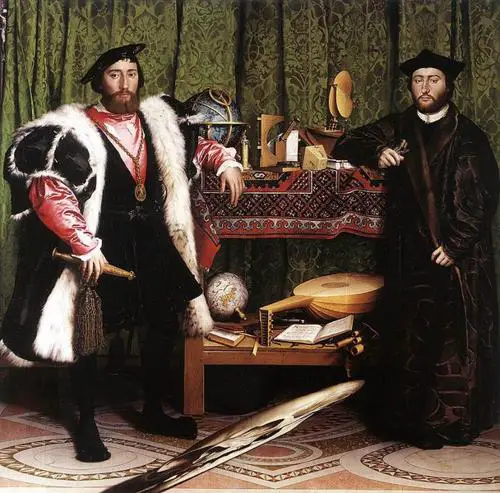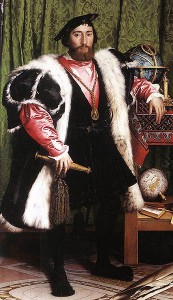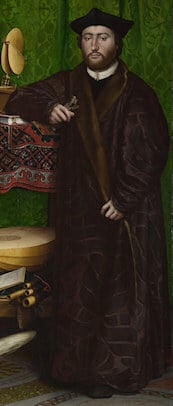Hans Holbein the Younger’s “The Ambassadors” is a painting I’ve written about before in my article on “Anne Boleyn’s Faith” and it’s a painting I want to look at again because there seem to be so many theories out there regarding this painting and what message it is sending.

It is widely known and understood that The Ambassadors is a puzzle or code. Like many Renaissance paintings, it is sending a message, and contains a wealth of symbols and themes. It is not just a portrait of two men standing in front of a table of random objects, it is an allegory, a labyrinth, and those objects have been purposely placed on that table to tell a story.
But what is the message and who is sending it and what on earth does this all have to do with Anne Boleyn?
Anne Boleyn and the Ambassadors
Well, historian and Anne Boleyn biographer, Eric Ives1, wonders if Holbein’s patron, Anne Boleyn, actually commissioned this painting. Anne had already commissioned “Mount Parnassus” from Holbein for her coronation and the fact that The Ambassadors must have been painting during the lead up to her coronation combined with the fact that the “shepherd’s” or pillar dial in the painting shows the date of the 11th April, the exact date when the royal court was informed that Anne was queen, implies that Anne Boleyn may well have commissioned this painting too. Olivia Peyton and Robert Mylne from the Facebook Anne Boleyn group2 also point out that the 11th April was the birthday of Marguerite of Navarre, sister of Francis I of France, author of Miroir de l’âme pécheresse or Mirror of the Sinful Soul (the famous reformist work that Anne’s daughter translated as a gift for Catherine Parr), and a woman who may have influenced Anne’s religious beliefs, so perhaps the painting, whose subjects were men who worked for Marguerite’s brother, was intended as a birthday present for Marguerite. We just don’t know, but if Anne Boleyn had something to do with this painting then it is worth exploring!
The Context of the Painting
The Ambassadors was painted in the Spring of 1533, a time described by the State University of New York, College at Oneonta, website as a “context of shifting political alliances, religious conflict, and changing fortunes”3.
It was painted during the lead up to the coronation of the pregnant Anne Boleyn, who had married Henry VIII secretly in the January. Henry and Anne had visited France in the autumn of 1532 to gain Francis I’s help and support for the annulment of Henry’s marriage to Catherine of Aragon, and his recognition of Henry’s relationship with Anne. Francis I responded by ordering French cardinals to negotiate secretly with Pope Clement VII to persuade the Pope to accept Henry’s request for the annulment. England was on the brink of breaking with Rome and France was suffering from religious divisions, with people like Lefèvre d’Etaples, Guillaume Briçonnet and Gérard Roussel calling for reform in the Church. An interesting time!
You can read more about the context of the painting, both political and religious in the article “Political and Religious Discord” at the State University of New York, College at Oneonta, website. There is also an excellent timeline showing the political and religious events of 1533 – click here to view.
John North4 also points out that Tudor people believed that Christ’s coming was imminent and that there had been predictions that Christ would return in 1532 or 1533. Easter 1533 was therefore an incredibly important moment, with it being a millenium and a half since Christ’s sacrifice on that first Good Friday.
The Sitters
As the name of the painting suggests, the sitters were indeed ambassadors – Jean de Dinteville, the Seigneur de Polisy and French Ambassador to England, and Georges de Selve, Bishop of Lavaur, and a man who served Francis I as ambassador to England, Venice and Rome.

Jean de Dinteville
Jean de Dinteville was a French nobleman who was born on 21st September 1504. His father, Gaucher de Dinteville, was a French courtier who held the position of Premier Maître d’Hotel to the Dauphin François (Francis) and Jean served as the royal children’s “Echanson” or Cup Bearer from 1521-1524. In the late 1520s he took over from his father as Bailly de Troyes, (the King’s representative in the “bailliage”, meaning that he was responsible for military matters and keeping order) and inherited the title Seigneur de Polisy on the death of his father in 1531. It is believed that he also replaced his father as a member of the Order of St Michael at this time too.
Dinteville’s time at court would have brought him into contact with fellow sitter, Georges de Selve, and also French Humanists like Lefèvre d’Etaples who was the tutor of the Duke of Angoulême in 1526.
A letter from the Imperial ambassador, Eustace Chapuys, to Emperor Charles V, dated 5th February 1533, records the departure of the French ambassador, Montpesat, and the arrival of his successor, Dinteville, so we know that Dinteville was serving Francis I as ambassador in 1533.
Georges de Selve

Georges de Selve was born around 1508 and was a member of a family who had “risen from the merchant bourgeois status to become judicial noblesse“. In the 14th and 15th centuries, the de Selves were merchants in the Limousin region, but things changed when, in 1505, Georges’ father, Jean, became a Président of the Exchequer of Normandy and then the Premier Président of the Exchequer in 1507. Louis XII noticed him around this time and in 1514 chose Jean to be one of the French diplomats sent to visit Henry VIII in England to negotiate the marriage between the French King and Henry’s sister, Mary Tudor. When Louis XII died in December 1514, his successor Francis I appointed Jean as “extraordinary ambassador to England” and then the Premier Président of the Parlement of Bordeaux. He then went on to become Vice Chancellor of Milan in 1515 and then Premier Président of the Parlement of Paris in 1520, the highest parliamentary office in France. The de Selve family had become important people.
Georges was Jeane’s third son and received a Humanist education to prepare him for a career in the Church. He worked his way up from a “clerk tonsuré” in Rouen to a “protonotaire apostolique” and then “chanoine” in Chartres Cathedral church. In 1526 Francis I chose Georges as the successor for the bishopric of Lavaur, and although canon law meant that he would not be able to hold it until he reached the age of 27, a papal dispensation was granted to allow him to become bishop. Francis I also chose Georges to serve him as an ambassador in England, Rome, Venice and Germany.
The State University of New York, College at Oneonta, website describes Georges de Selve as being “a member of the moderate, French reformers in the circle of Lefèvre d’Etaples” and states that d’Etaples dedicated his Psalterium David to Jean de Selve in 1524. The website also states that “Georges’ writings echo the thoughts of Lefèvre. For example, like Lefèvre, Georges places a heavy emphasis on Justification by Faith.”. So, Georges held reformist views.
Friendship?
We do not know for sure what relationship existed between Dinteville and de Selve, but in her article “Friendship and Immortality: Holbein’s Ambassadors revisited”5, Kate Bomford argues that Holbein’s painting is a representation of friendship and cites the evidence found by Mary Hervey, who wrote about the painting at the turn of the century, which included a fragment of parchment which described de Selve as the “intime amy” of “Dinteville & de toute sa famile” and a copy of a memorandum of an acquaintance of Dinteville’s niece who described de Selve as Dinteville’s “intime ami”. Bomford also wrote of how there were clues in the painting of a relationship between the two men:-
- De Selve’s gown – Smart but informal daywear, suggesting an informal encounter between him and Dinteville.
- Dinteville’s Order of St Michael – The painting shows Dinteville wearing his Order of St Michael pendant on a simple gold chain rather than the ceremonial collar. Bomford writes of how “the statutes of the Order as published in 1512 permitted that on certain occasions, including when at home in private, or ‘en autres lieux ou ils n’auront aucune compagnie ou assemblée de gens d’estat’, the pendant of St Michael might be worn on a gold chain or silk lace rather than suspended from its ceremonial collar.” This suggests that Dinteville viewed his encounter with de Selve as “an intimate, off-duty relationship rather than a formal gathering of gens d’estat.”
- The Representation of the men – Bomford points out that Holbein represents the sitters as friends by evoking marriage portraiture. He “echoes the near-ubiquitous arrangement for the representation of betrothed or married couples at this date” in the way that he has posed them and in his use of colours.
- The composition – Bomford thinks that the composition of the painting, “with the books and scientific and musical instruments that occupy the central part of the painting between Dinteville and de Selve” suggests “shared knowledge, interests and pursuits” and so friendship.
- The existence of the portrait itself – Bomford writes that the most compelling evidence for a relationship between these two men is the actual existence of the painting, the fact that these men were painted together and were both in England on diplomatic missions at the same time. Bomford writes that “there is also ample evidence that de Selve visited Dinteville during this period. The copy of Camusat’s memorandum and the summary of his correspondence with the Godefroy brothers refer to the visit, as do the parchment fragment discovered by Hervey, and two extant letters from Dinteville to his elder brother François, Bishop of Auxerre – the earlier of which also expresses Dinteville’s pleasure at the event, thus supporting the existence of a friendship between the two men.”
Signs, Symbols and Puzzles
As I said earlier, the painting is a Renaissance puzzle and you can spend many hours examining it, looking at all the details and trying to fathom out exactly what Holbein is saying. The marvellous thing about this painting is that nobody knows for sure what this painting is saying! Holbein left no guide to it so all we can do is theorize. Read my next article, Part Two: Symbols, to find out the many theories regarding the symbolism in this beautiful painting.
Notes and Sources
- The Life and Death of Anne Boleyn, Eric Ives
- Anne Boleyn Facebook group, created by Olivia Peyton and Robert Mylne
- The Oneonta Website – Various pages on The Ambassadors
- The Ambassadors’ Secret, John North
- “Friendship and Immortality: Holbein’s Ambassadors revisited”, Kate Bomford, Renaissance Studies Vol. 18 No. 4